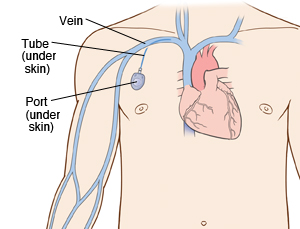Vascular Access Port Implantation
Port implantation is surgery to place (implant) a port under the skin. For vascular access, it's placed into a vein. The port allows medicines or nutrition to be sent right into your bloodstream. Blood can also be taken or given through the port. During the procedure, a thin, flexible tube (catheter) is threaded into one of your large veins. The tube is then attached to the port. This usually sits under the skin of your chest and causes a small bump. To use the port, a special needle is passed through your skin and into the port. The needle can stay in your skin for up to 7 days, if needed. A port can stay in place for weeks, months, or longer.

Why is a vascular access port needed?
A vascular access port may allow healthcare providers to give you:
-
Chemotherapy or other cancer-fighting medicines
-
IV treatments, such as antibiotics or nutrition
-
Hemodialysis for kidney failure
The port may also be used to draw blood.
Before the procedure
Follow any instructions you are given on how to get ready.
Tell your provider about any medicines you are taking. This includes:
-
All prescription medicines, especially blood thinners
-
Over-the-counter medicines such as aspirin or ibuprofen
-
Herbs, vitamins, and other supplements
Also be sure your provider knows:
-
If you are pregnant or think you may be pregnant
-
If you are allergic to any medicines or substances, especially local anesthesia or iodine
-
Your full health history, including why you will need the port. Also tell your provider if you have a condition that makes your blood more likely to form clots.
-
If you plan on doing any contact sports
During the procedure
-
Before the procedure, an IV may be put into a vein in your arm or hand. This gives you fluids and medicines. You may be given medicine through the IV to help you relax during the procedure. This is called sedation. But some surgeons place ports using general anesthesia.
-
The chest is used most often for the port. In some cases, your belly (abdomen) or arm will be used instead.
-
The skin over the insertion area is numbed with local anesthesia.
-
Ultrasound, X-rays, or both are used to help the healthcare provider guide the catheter into the correct place during the procedure.
-
A cut (incision) is made in the skin where the port will be placed. A small pocket for the port is formed under the skin.
-
A second small incision is made in the skin near the first incision. A tunnel under the skin is created. The catheter is put through the tunnel and into the blood vessel.
-
The skin is closed over the port. It's held shut with stitches or surgical glue or tape. The second small incision is also closed.
-
A chest X-ray may be done to make sure the port is placed correctly.
After the procedure
You may be taken to a recovery room to recover from the sedation. Nurses will check on you as you rest. If you have pain, nurses can give you medicine. If you are not staying in the hospital overnight, you will be sent home a few hours after the procedure is done. A healthcare provider will tell you when you can go home. An adult family member or friend will need to drive you home.
Recovering at home
-
Take pain medicine as directed by your healthcare provider.
-
Take it easy for 24 hours after the procedure. Don't do any physical activity or heavy lifting until your healthcare provider says it’s OK.
-
Keep the port site clean and dry. Ask when you can shower again. You will need to keep the incision dry until it heals by covering it when you shower.
-
Care for the insertion site as you are directed.
-
Don’t swim, bathe, or do other activities that cause water to cover the insertion site.
-
Your port needs to be flushed at least every 4 to 6 weeks to keep it from getting blocked with blood clots. Talk with your healthcare provider about who will do this for you.
-
In some cases, you may be taught how to flush it yourself.
Risks and possible complications of implantation
-
Bleeding
-
Infection of the insertion site
-
Damage to a blood vessel
-
Nerve injury or irritation
-
Skin breakdown over the port
-
Rarely, collapsed lung (for chest port placements)
Risks and possible complications of having a port
-
Blocked port or catheter
-
Leakage or breakage of the port or catheter
-
The port moving out of position
-
Blood clot
-
Skin or bloodstream infection
-
Skin breakdown over the port
When to call your healthcare provider
Call your healthcare provider right away if you have any of the following:
-
A fever of 100.4° F ( 38.0°C) or higher, or as directed by your healthcare provider
-
Chills
-
Swelling, bleeding, or a collection of blood (hematoma) around the port insertion site
-
Skin near the port that is red, warm, swollen, or broken
-
Shoulder pain or arm numbness, weakness, or tingling on the side where the port is located
-
You feel a heart flutter or racing heart
-
Swollen arm, if the port is placed in your arm
-
Cough, shortness of breath, or trouble taking a full, deep breath